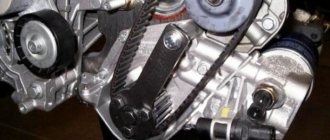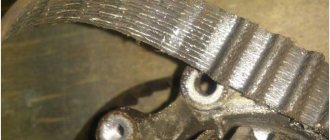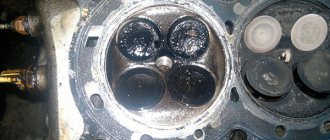- VAZ 21126 is a classic Priorov engine, which was the first on these cars. Thanks to changes in the design, namely the lightening of the connecting rod and piston group, there was no room left for valve recesses in the pistons. As a result, when the timing belt breaks, which sometimes happens on Priora, the valves are bent, and sometimes even the pistons are damaged.
The VAZ 21116 engine is a simpler 8-valve engine that Priora inherited from Granta. In appearance, it is practically no different from a conventional 8-valve injection engine, but inside, again, there are lightweight pistons, which leads to the already familiar consequences in the event of a timing belt break - valve bending. But it is worth noting that the load on the timing belt of 8-valve engines is slightly lower than that of 16-valve engines, and such problems are less common with such power units.
AVTOVAZ modified 1.6-liter engines to prevent valve bending, new details
On modern VAZ engines, when the timing belt breaks, the valves “meet” the piston, which causes critical damage and requires expensive repairs. In this regard, AVTOVAZ decided to modernize the line of engines by installing new pistons that will eliminate such damage, writes CARscope.ru, citing its sources.
The plant's supplier, Federal Mogul, has mastered the production of pistons with recesses (holes, counterbores) in the bottom. Motors with such pistons are popularly called “plug-free”, that is, when the timing belt breaks, the valves do not “plug” into the pistons, the bottoms of which have special grooves for this case.
The new piston group is designed for a range of 1.6-liter engines that are installed on the Lada Granta, Kalina, Largus, Vesta, XRAY models:
- VAZ-11186 (8 cells, 87 hp)
- VAZ-21126 (16 cells, 98 hp)
- VAZ-21127 (16 cells, 106 hp)
- VAZ-21129 (16 cells, 106 hp)
For the 1.8-liter engine with the VAZ-21179 index, a modified piston group is not provided.
Update 08/29/18
: The day before the opening of MIAS-2018, AVTOVAZ representatives presented the updated Lada Granta family to the media. Now, on all Granta engines - both 8-valve and 16-valve - they use “stickless” pistons, that is, with grooves where the valve “falls” if the timing belt breaks, and the piston pushed up by inertia will go to it towards. Nikita Gladky (product manager) told Kolesa.Ru about this.
Update 09/04/18
: The website Lada.online clarified the information in the official LADA group on VK. Answer:
To the question “both Vesta and XRAY with 1.6 liter?” They answered like this:
Later, AVTOVAZ customer service reported:
Lada Largus also received such an engine modification, because This car is equipped with similar 1.6-liter engines.
Update 09/06/18
: A slide titled “Engine piston design change” has leaked online. It states that new pistons are used for all engines (only 1.6-liter engines are shown in the photo). The holes in the bottom of the piston for the full stroke of the valves eliminate the possibility of sticking the valves into the piston if the timing kinematics are disrupted (for example, if the belt breaks).
A new coating and a change in the side profile of the piston skirt made it possible to increase the wear resistance of the pistons and, as a result, reduce the tendency of engines to knock and increase fuel consumption.
Do you want to see this modification on 1.8-liter engines? This will happen if the brand “sees a clear request from the consumer,” who “has not yet expressed such wishes.” Simply put, if you want to get a “no problem”, write letters to the factory. This was reported to auto.mail.ru by Sergey Kornienko, head of the Lada brand product portfolio development department.
According to unofficial information, “stickless” pistons began to be installed from engine number 3920500.
Update 09/16/19
: A source directly related to the production of VAZ 21179 engines sent us a photo and told us some more details:
Source
AVTOVAZ modified 1.6-liter engines to prevent valve bending, new details
On modern VAZ engines, when the timing belt breaks, the valves “meet” the piston, which causes critical damage and requires expensive repairs. In this regard, AVTOVAZ decided to modernize the line of engines by installing new pistons that will eliminate such damage, writes CARscope.ru, citing its sources.
The plant's supplier, Federal Mogul, has mastered the production of pistons with recesses (holes, counterbores) in the bottom. Motors with such pistons are popularly called “plug-free”, that is, when the timing belt breaks, the valves do not “plug” into the pistons, the bottoms of which have special grooves for this case.
The new piston group is designed for a range of 1.6-liter engines that are installed on the Lada Granta, Kalina, Largus, Vesta, XRAY models:
- VAZ-11186 (8 cells, 87 hp)
- VAZ-21126 (16 cells, 98 hp)
- VAZ-21127 (16 cells, 106 hp)
- VAZ-21129 (16 cells, 106 hp)
For the 1.8-liter engine with the VAZ-21179 index, a modified piston group is not provided.
Update 08/29/18
: The day before the opening of MIAS-2018, AVTOVAZ representatives presented the updated Lada Granta family to the media. Now, on all Granta engines - both 8-valve and 16-valve - they use “stickless” pistons, that is, with grooves where the valve “falls” if the timing belt breaks, and the piston pushed up by inertia will go to it towards. Nikita Gladky (product manager) told Kolesa.Ru about this.
Update 09/04/18
: The website Lada.online clarified the information in the official LADA group on VK. Answer:
To the question “both Vesta and XRAY with 1.6 liter?” They answered like this:
Later, AVTOVAZ customer service reported:
Lada Largus also received such an engine modification, because This car is equipped with similar 1.6-liter engines.
Update 09/06/18
: A slide titled “Engine piston design change” has leaked online. It states that new pistons are used for all engines (only 1.6-liter engines are shown in the photo). The holes in the bottom of the piston for the full stroke of the valves eliminate the possibility of sticking the valves into the piston if the timing kinematics are disrupted (for example, if the belt breaks).
Does the Lada Granta engine bend valves? Answer for engines 8 and 16 valves
Some say it is oppression, others say it is not. Who is right? And those and others. I'll explain why.
It all depends on what kind of Grant you have - 1st generation or restyling.
For the 1st generation Grants, two engines were installed: 11183 with 82 hp. and 11186 for 87 hp. Engine 11183 does not bend the valves. On engine 11186 until 2022, when the timing belt broke, the pistons met the valves and bent their legs.
The 2nd generation Grants are equipped with an 8-valve engine 11186 and 16-valve engines 21126 and 21127. I’ll talk about them below. Now let's look at the 8-valve.
This is the same engine as on the first Grant. But it has been modernized. In 2022, they began installing an updated version of the 11186 engine on restyled cars, in which the possibility of pistons meeting valves was structurally excluded. To do this, they began making recesses on the bottom of the pistons, which solved the problem.
16-valve engines are also plugless. Therefore, if you have a 2nd generation Lada Granta, released in 2022 or later, sleep well - all engines in the line are now plug-inless. This means: if the timing belt breaks, the engine will not bend the valves.
✅ Granta 1st generation, engine 11183 (82 hp) - DOES NOT bend
✅ Granta 1st generation, engine 11186 (87 hp) - oppression
✅ Granta 2nd generation (restyling), which has been produced since 2022 to this day - DOES NOT bend on all engines
Like and subscribe to the channel! This is how you help him develop.
Source
What cars are equipped with the VAZ 11186 engine?
The Lada Kalina 2 and Granta with manual transmission are equipped with the 11186 engine. The engine is found on Datsun cars built on the Granta and Kalina platforms.
Automobile model
Years of manufacture
| Lada Granta | sedan | since 2011 |
| liftback | since 2014 | |
| hatchback | since 2018 | |
| station wagon | since 2018 | |
| Lada Kalina 2 | station wagon | 2013 — 2018 |
| hatchback | 2013 — 2018 | |
| cross | 2014 — 2018 | |
| Datsun on-Do 1 | sedan | since 2014 |
| Datsun mi-Do 1 | hatchback | since 2015 |
Modifications of 8 and 16 valve Lada Granta engines
A car of this family is equipped with one of five types of power units, namely:
The bend of the valve stem is typical for all of the above modifications of power units, with the exception of the VAZ-11183-50. The reason lies in the absence of a defect in the design of the gas distribution mechanism (GRM).
If the drive belt suddenly breaks, the camshaft continues to rotate, while the crankshaft immediately stops due to the lack of rotational movement.
When the crankshaft stops, the cylinder pistons hit the valve stems (seats). Consequences: deformation of the structure, breakage of the metal base.
Nikolay GANYUSHKIN, head of the engine design bureau
The modernization of the eight-valve engine for front-wheel drive models took two years. The main goals were to reduce fuel consumption and increase dynamic performance by reducing mechanical engine losses, and at the same time reducing harmful vibrations and noise. And of course, increased reliability. Euro 4 standards require that the engine maintain its original emissions parameters twice as long - up to 160 thousand km. And we almost doubled the resource: from 120 thousand to 200 thousand km. The connecting rod and piston group of the VAZ-21116, like the sixteen-valve one, is purchased. In the future, we plan to produce some parts ourselves, and we will continue to purchase some from foreign partners from the Federal Mogul group, who intend to localize the production of components in Russia. We also take into account the interests of the Renault-Nissan alliance. If engine production volumes increase, then it would be reasonable to purchase additional equipment and organize the production of connecting rod and piston group parts in Togliatti.
1_no_copyright
The modernization of the eight-valve VAZ-21114 engine was brought closer by two major events: the release of Grants to the market and the transition of the entire model range to the next environmental level - Euro-4. And although the old 1.6-liter, despite its advanced age (its roots stretch back to the mid-80s of the last century), did not look like a frail old man, new standards and trends required extensive changes. At the same time, the possibilities for maneuver for motorists, as often happens, were narrowed by financial limits.
Therefore, we went along the already beaten path. After all, several years earlier, a 16-valve engine of the same volume (VAZ-21126) underwent an update, on which some technical solutions were tested. Moreover, they were able to unify not only the approach, but also many details, for example, a connecting rod with liners, a piston pin and rings. The cylinder block, although with its own index, is exactly like that of the VAZ-21126 engine: with additional nozzles for cooling the pistons with oil and plate-honing of the cylinder walls, which reduces the break-in time.
However, it was not possible to copy all the changes exactly: organizing the workflow in an engine with two valves per cylinder is more difficult. Moreover, the requirements for the modernized eight-valve engine turned out to be stricter. Take, for example, the resource - 160 thousand km for the VAZ-21126 and 200 thousand km for the VAZ-21116. Photos with captions will tell you what was changed and why.
H
The new H-intake module was tested on an intermediate version - the VAZ-11183-50 engine (with a Euro-4 catalytic converter, but with a heavy connecting rod and piston group). Even without relief, only by optimizing the intake and exhaust it was possible to improve the main characteristics.
Reviews
| № | Positive |
| 1. | Vasily: I have a Granta with a VAZ-11183-50 engine, it works properly. I don’t allow sudden timing breaks; I always maintain an interval of 40,000 km. |
| 2. | Konstantin: a year ago I bought a VAZ-21126 with a motor. I heard that the valves often bend, but I strictly follow the instructions and buy only high-quality belts. |
| 3. | Vladlen: Once the belt broke on Grant, it was my fault, because I was overdue. Since then I have never violated it. |
| 4. | Ignat: the car is still being serviced, I strictly observe the intervals. Violations are unacceptable. |
| 5. | Ivan: even before buying the Lada Granta, I heard about the problem with bending. Compliance with maintenance deadlines is the main safety factor. |
| Negative | |
| 1. | Vitaly: I had a timing break already at 150,000 km. The car is new, still under warranty. It’s not my fault, since the deadlines haven’t expired. I sent it to the workshop for troubleshooting. |
| 2. | Kirill: filed a lawsuit against the car dealer. After installing a new timing belt, it broke at 7000 km. The car is currently in the service station. |
| 3. | Slavik: I had a valve stem break at 30,000 km. Obviously the timing belt was defective. The car is in the service station, the technicians are carrying out troubleshooting. |
How to prevent valve base from bending
Compliance with technical inspection intervals is rule No. 1 for preventing sudden car breakdowns.
Bent valves in a row
The operation of the timing belt is discussed in detail in the article https://remont-avtovaz.ru/remen-grm-na-lade-granta/. We just remind you that the manufacturer recommends replacing the timing belt every 40,000 km. Violation of the technical inspection period of the car increases the risk of its further use, creating an emergency situation on the road.
Shoals
For this money today the Lada Granta is the only option. The question is different - not a single car leaves the VAZ assembly line without problems. In general, cars are reliable; many can travel 200, or even 300,000 km without major repairs. Consumables and suspension are not taken into account. This can happen to any brand.
Trunk is too big
This thing is not clear. For example, I bought a car and I know that it will be driven by 2 people in front and the same number in back. Why make a huge trunk with a volume of 520 liters, and infringe on the rear passengers? Their feet are resting on the front seat backs!
There are companies that make large vans (firefighting, medical) on the Lada Granta chassis. Why make a huge trunk in a sedan and infringe on passengers?! It can be reduced and made like Vesta’s - 450 liters. This is quite enough.
Rear seats
If you make a little more room for rear passengers, car sales will increase. In general, the rear sofa is comfortable, budget class. Although the backrest can be tilted more. But it’s depressing that the legs rest against the backrest, and long-distance trips will be uncomfortable. If you sit in Granta Sport, then after 1 hour you will not straighten your back. There is a topic for a separate discussion.
Ceiling
It is not particularly intrusive for a person of average height. But headroom is limited for tall passengers.
How the new Lada Granta turned out
The designers took the front part of the Vesta, the Kalina torpedo - a new Granta was developed. Of course, there are small innovations, such as tufted fender liners and lateral seat support. This is where the modernization ended.
The main shame
Try opening and closing the back door - you hear a metallic knock. This is a real shame for AvtoVAZ! Everyone talks about plug-in engines and fashionable innovations, but they can’t make the doors close properly. The locks are stone age; on previous models the doors also closed (VAZ-2107, Niva).
Trunk
Many will argue that this is a budget car, and there is no point in finding fault with it. Open the trunk and look at the lid - solid iron.
Lada Granta engines 8 valves
This power unit was installed only until December 2014, until it gave way to the 11186 internal combustion engine. This is an injection 8-valve engine with a single camshaft, a timing belt drive and without hydraulic compensators, so the thermal valve clearances here will have to be adjusted yourself. Thanks to special holes in the pistons, if the valve belt breaks, it will never bend.
There are plenty of problems with this engine; first of all, owners are bothered by all sorts of noises, knocks, and vibrations. Unreliable electrics, as well as a capricious thermostat, can throw you many unpleasant surprises. Due to poor fuel, valve burnout sometimes occurs here.
Sedan before restyling 2011 – 2019
| 1.6 l 11183 MKP5 | |
| Type | injector |
| Fuel | gasoline AI-92 |
| Location | transverse |
| Cylinders | 4 in a row |
| valves | 8 |
| Working volume | 1596 cm³ |
| Power | 82 hp |
| Torque | 132 Nm |
| Acceleration to 100 km/h | 12.6 s |
| Speed (max) | 165 km/h |
| Ecological Class | Euro 4 |
| Consumption city | 9.7 l |
| Flow track | 6.1 l |
| Mixed flow | 7.4 l |
Similarly, the Motor VAZ website talks about all the details of the internal combustion engine design
This unit is an improved version of the previous one. There is already a lightweight piston with anti-friction inserts, a timing belt from Gates with a service life of 180 thousand km, an electronic throttle valve, a developed cooling jacket and many other improvements, thanks to which it was possible to fit this rather old engine into the strict EURO 4 econorms. Due to the new pistons without holes in the bottom, if the valve belt breaks, it almost always bends. Update: in mid-2022, the manufacturer equipped the unit with plugless pistons.
Technical characteristics of the VAZ 11186 1.6 8kl engine
In-line 4-cylinder 8-valve engine 11186 (VAZ 21116) was released in 2011. The unit is built on the basis of 11183, but is faster and more economical. This was achieved through a large number of improvements:
- increased the volume of the combustion chamber to 30 cm3;
- reduced the size of the bolts for the cylinder head and cylinder head coupling to M10, which ensures the tightness of the joint with less tightening force;
- strengthened the cylinder head;
- an automatic tensioner was added to the camshaft drive;
- piston cooling nozzles appeared;
- modernized the water pump by installing more reliable bearings and seals;
- the engine was equipped with distributed injection with an automatic throttle valve;
- The thermostat and cooling circuit were modified.
Specifications
| Engine | VAZ | Renault | |||||||||||
| Engine index | 21213, 21214 | 11183 | 11186, 11189 | 11182 | 21126 | 21127 | 21126-77 | 21129 | 21179 | 21179-77 | HR16DE/H4M | K7M | K4M |
| Applicability | Lada 4x4, Niva Chevrolet | Granta, Kalina | Granta, Kalina, Largus | Largus, Granta | Granta, Kalina, Priora | Granta and Kalina sport | Vesta, XRAY, Largus | Vesta sport | Vesta, XRAY | Largus | |||
| Number of valves | 8 | 8 | 16 | 8 | 16 | ||||||||
| Engine volume, l | 1,7 | 1,6 | 1,8 | 1,6 | |||||||||
| Power, hp | 81 | 82 | 87 | 90 | 98 | 106 | 120 | 106 | 122 | 145 | 110 | 84 | 105 |
| Is the valve bending or not? | Yes, chain | No | Yes (until 08/15/18) | No | Yes (until 08/15/18) | Yes (until 08/15/18) | Yes | Yes (until 08/15/18) | |||||
| Volume, l | 1,6 | ||||||||||||
| Power, hp, rpm | 87/5100 | ||||||||||||
| Torque, Nm, rpm | 140/3800 | ||||||||||||
| Cylinder, diameter in mm | 82 | ||||||||||||
| Piston stroke, mm | 75,6 | ||||||||||||
| Fuel | gasoline AI-95 | ||||||||||||
| Consumption, l: city | 8,5 — 9,0 | ||||||||||||
| track | 5,3 — 5,8 | ||||||||||||
| mixed | 6,8 — 7,3 | ||||||||||||
| Resource, km | 200 000 | ||||||||||||
Comfort package overview
The car is equipped with an 8-valve engine producing 87 hp, the equipment can be called average. I like the silver color. The cost is 522,500 rubles including paint. If the color is white, the price will drop by 6,000 rubles.
The car has a small set of options, but the most necessary ones are there:
- Air conditioner.
- Electric power steering.
- Electric windows.
- 2 airbags.
- Heated seats.
We won’t pay much attention to the configuration; everyone already knows about this.
Driving impressions
Lateral support in the seats has, of course, improved, but it is not sufficient. The visibility in Lada Grant is not bad, even better than in Vesta. I like the large mirrors, but at speeds over 120 km per hour they start to whistle. What causes the whistling is still unclear. The suspension works fine, not too soft, but in large potholes it breaks. On small uneven surfaces - no problem.
When accelerating over 100 km, the steering wheel is as soft as when driving slowly. This is wrong, at high speeds the steering wheel should fill up and become stiffer for safety. When driving over small bumps, the rear windows and glove compartment rattle. It is useless to apply under warranty - they will not do anything.
What do you like
The engine pulls well from the bottom, and the difference with the 16-valve engine in terms of torque is small. At the start there is no big difference between them. You shouldn't look at horsepower, as it doesn't affect acceleration dynamics. The 8-valve unit will not be enough only when the car is heavily loaded and the air conditioning is on. By the way, when it idles, you can feel a strong detonation in the body.
It’s hard to say what will happen to the engine in 5 years. The suspension breaks, but not often. Its reliability is high; owners rarely repair the chassis. I don’t know why the windows are knocking, they are completely closed.
To buy or not
With this money, people have no other choice. The car has been in 1st place in sales for several years now. AvtoVAZ is constantly working to eliminate problems on its cars, I hope that it will take our statements into account. In the future, cars will be of higher quality and will require fewer repairs. Whether it's worth buying is up to you to decide.
Subscribe and don’t miss important channel publications, write your opinion. Good luck to all!
Is it possible to tune the Priora 126 engine?
Even with a strong desire, the 126 engine will not be able to reach a speed of 100 km/h in a few seconds. Without tuning the Lada Priora engine, overtaking prestigious brands will also not be possible.
According to many motorists, it is necessary to install a turbocharger from the very beginning. In this case, the engine power will increase by no more than 15 - 20%. Special filter elements are additionally installed here to clean the cold air as it enters the engine.
The main improvements to the 21126 motor are:
- cylinder boring;
- increase in piston stroke.
With the help of these modifications, it is possible to most effectively boost the 126 engine, the power of which increases by 50 horsepower. The main purpose of boring is to increase the volume of the cylinders. The process comes down to primitive actions:
- cylinder walls are reduced in thickness;
- more gasoline is burned in the resulting volume;
- engine performance increases;
- power increases.
Important: When burning more fuel, the temperature of the Lada Priora engine increases sharply. Frequent overheating leads to breakdowns of working elements and failure of the motor itself. To avoid costly overhauls, it is recommended to provide additional oxygen to the engine. For this purpose, a radiator with wide grilles is installed, and additional holes are drilled under the air intake on the hood.
Lada Granta FL received “plug-in” engines
The engines of the updated Lada Granta FL received a new piston, which does not bend the valve if the timing belt breaks.
As you know, one of the disadvantages of modern engines is the bending of valves when the timing belt breaks. It is quite difficult to predict the life of a belt, since it can break not only due to wear, but also if the pump or tension roller is jammed.
When the timing belt breaks, a modern engine usually bends the valves on the pistons. This leads to expensive repairs.
According to the Avtosptavochnaya.com portal, this problem has been solved on the new Lada Granta FL. The plant's supplier, Federal Mogul, has mastered the production of pistons with special recesses. Thanks to this shape, both pistons and valves will remain intact even if the timing belt breaks.
The new piston group will be installed on 1.6-liter AVTOVAZ engines from mid-July 2022:
- 8-valve VAZ-11186 with a power of 87 hp. With.
- 16-valve VAZ-21126 (98 hp)
- 16-valve VAZ-21127 (106 hp)
Let us remind you that these are the engines that the new Granta received:
- 1.6, 87 hp + manual
- 1.6, 98 hp + automatic (Jatco)
- 1.6, 106 hp + mechanics or AMT robot
That is, owners of Lada Granta FL may not be afraid of valve bending in the event of a timing belt break.
Engine disassembly and repair
Repairs are carried out according to the standard procedure - we find faulty parts and replace them with working ones. The instructions below describe the process of disassembling the unit itself; before that, you need to dismantle it from the Lada Priora and thoroughly clean it of grease and dirt.
From the tools we will need regular and ring wrenches, a ratchet with an extension, screwdrivers, a pry bar and a stand. It is best to carry out repairs in a garage with good lighting.
Instructions
- Using the 13th key, remove the bracket fastenings. 4 nuts hold the front cylinder block support;
- We remove the bracket and move on to the left support - it is removed in exactly the same way;
Thus, you can completely disassemble the 16-valve engine and repair and replace faulty parts. But if the unit bends the valve, then only an experienced mechanic can handle the malfunction with his own hands. In any case, you will find out whether the motor bends the valves or not after removing the head cover.
Useful tips on the topic
Following the recommendations will make life easier for the driver and the engine of his car:
- find out whether the valves in your car’s engine are bent using a table, a reference book, or with your own hands;
- Carry a spare timing belt with you;
- buy a good quality belt (it’s better to always use the same brand);
- periodically check the belt tension and conduct a visual inspection for cuts, burrs, and detachments of ropes;
- when buying a used car from a stranger, it is recommended to change the timing belt, even if the former owner said that he recently replaced it;
Source
Engine operating temperature
We have learned the resource, now we move on to another important indicator. The optimal operating temperature is 90-95°C. After 97°C, engine number 126 with 16 valves will “slow down” a little, but according to the rules, temperatures up to 100°C are considered normal. If the Lada unit is operated with this indicator, then you need to be sure that the radiator fan is running at this time. When you see an indicator below +90°C on the dashboard, you need to assume that this is underheating. Of course, in cold weather the power plant needs more time for the temperature to reach normal levels.
- Operating temperature – 90-95°C.
- Normal temperature (engine runs worse) is 97-110°C.
- Reduced temperature – 90°C and below.











